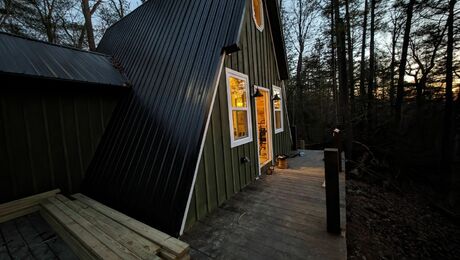Vinyl siding? On the cover? What were you thinking?
Have you sold out to the plastics industry? Vinyl siding on a “fine” home? Even worse, on your cover (FHB #149)? What has happened to your magazine? Please return to supporting quality materials and workmanship, skillful techniques and pride.
—Bill Metz, via email
My apologies to the vinyl industry, but I don’t think I will ever hear someone say, “What a beautiful piece of PVC, and look how well it has been snapped into position.”
—Jim Matthew, Denman Island, BC, Canada
Like me, most readers are seeking inspiration in thoughtful architecture, artistic integrity in building, quality and honesty in materials, and innovation in tools. I find the inclusion of vinyl siding offensive. The fact that it was deemed worthy of cover space is downright alarming.
—David Sofio, Honolulu, HI
You would not put a piece of cling film over an original painting. Why would you cover your house in vinyl? With so many new cement-board products that are inexpensive, durable and aesthetically pleasing, why would anybody consider vinyl? The credibility your magazine gives to this cheap and aesthetically poor product is disturbing, and personally, I think your magazine has dropped a few notches.
—Robert James, Austin, TX
Vinyl as a building product is an aesthetic and architectural travesty and has caused untold damage to this country’s architectural heritage. It has no place in a magazine devoted to quality home building, and vinyl’s presence on your cover is an absolute disgrace.
—Ellen Majdloch, via email
Only in Fine Homebuilding would we find an article about the best way to install vinyl siding paired with an article questioning whether we should be using vinyl at all (FHB #149, “Does Vinyl Siding Belong on a Fine Home?” pp. 89-90).
First, it would have been more meaningful to compare the environmental problems with comparable problems for wood and cement siding—fair is fair!
More important, Fine Homebuilding missed an opportunity to address the bigger issues about the use of vinyl siding: It looks cheap, it feels cheap, it leaks, and when a coat of paint is needed after the integral color fades, the manufacturer’s warranty is often voided.
Maybe it should be no surprise that in our throwaway society, a product that’s cheap and looks okay (at least from a good distance) will be well received despite so many negative qualities.
—Bill Spikowski, Fort Myers, FL
Kevin Ireton, editor-in-chief, replies: I don’t particularly like vinyl siding, and I’m not about to install it on my 200-year-old Cape. But despite my personal feelings, vinyl is the most commonly used siding material in the country. Lots of people love it, including many of Fine Homebuilding’s readers. But more important, many of our professional readers are asked to install vinyl siding, whether they like it or not. I think it’s our duty to help those builders install the vinyl correctly so that the structure of the home won’t be damaged by leaks and so that the vinyl itself will last as long as possible.
Mike Guertin, author of “Vinyl Siding Done Right,” replies: What pops into my mind when I read the letters critical of vinyl siding is asphalt roof shingles. I can only imagine what an uproar there would have been if asphalt shingles had been on the cover of FHB in 1924. Many of the same issues that readers bring up when criticizing vinyl would have been equally applicable to asphalt shingles: ugly, cheap-looking, environmentally incorrect, trying to look like something they aren’t (slate or wood shingles), short-lived, less resistant to wind and water. Today, few people still hold to those criticisms. Covering 85% of all homes in North America from affordable to mini-mansions, asphalt shingles somehow outlived the criticism and barely raise an eyebrow. I’m not trying to justify vinyl, just to put the controversy in perspective.
Don’t clamp loads onto your truck
I learned a lot from John Carroll’s excellent article “Using Clamps Outside the Box” (FHB #150, pp. 62-65). But I’d never, ever hold sheets of drywall or plywood on top of a cargo rack of a mini-pickup with four
C-clamps. Vibration, even on a short trip, could easily cause the clamps to loosen. The hapless driver might then find his cargo scattered to the four winds or, worse, through another driver’s windshield. Even if only one clamp loosened, what might it hit if it fell?
A better way to hold such cargo to a rack is with the medium-duty cargo straps that can be tightened with their own built-in ratchets. (I use these things for a variety of purposes, only some of which involve what was intended.) Can they loosen? Yes, to a very limited degree, due to stretching of the woven strapping. However, in a sudden stop or heavy acceleration, even a strap that’s slightly loose from stretching is automatically tightened.
—Rick Shaffer, Sedona, AZ
Nantucket project raises questions
I enjoyed David Bentley and Elizabeth Churchill’s “Restoring Flaggship” in FHB #149 (pp. 110-115). I have passed the building frequently while walking the Sconset cliff path, both while the house was under construction and since. No expense was spared in materials and labor, and it is certainly pleasing to the eye, but the project raises two important questions.
First, what do you call a project like this? Despite the title, it is not a restoration because the resulting building, particularly the interior, bears only a superficial resemblance in spirit and in form to the original building. It is someone’s idea of what the building should have been rather than a restoration of what it was.
It isn’t a renovation, either, because little if any of the original structure and surfaces have been renewed: The building was gutted, and most of the structure and all of the surfaces were replaced—attractively replaced, but replaced. So it isn’t a renewal of an existing building but a remodeling in the literal sense, a kind of fantasia on the theme of Victorian cottage projected on an existing building. These may seem like nitpicking questions, but they reflect an increasingly big political issue on Nantucket, where construction is tightly controlled.
Second, this project makes me ask at what point architects as professionals should resign a commission. It is pretty clear from the article that there was conflict with the client over removing the fireplace and leaving the phony chimney, and it is hard to imagine a professional architect being happy about the Sub-Zero refrigerators and restaurant-style stove in a guest cottage. My wife and I are both professionals in other fields, and we have both fired clients. At what point does an architect tell clients that what they want to do is so entirely inappropriate that they must find someone else to finish the job? This again is a growing question on our island, where many can afford whatever they want, however inappropriate the context.
—Marshall Keys, Nantucket, MA
Clarifying the electrical code
Having reviewed Clifford A. Popejoy’s article “Installing an Electrical Service” (FHB #150, pp. 78-85), I found errors in his interpretation of the National Electrical Code (NEC):
NEC 230.9(A) – Clearance from Building Openings. The clearance requirements for building openings are from building openings to the service conductors. This clearance requirement would include the conductors in the drip loop. The service shown in the drawing on p. 79 would be found in violation.
NEC 230.24(B)(1) – Vertical Clearance from Ground. The 10-ft. vertical clearance to pedestrian-accessible (only) surfaces is measured from the bottom of the drip
loop. Again this is not what is indicated in the drawing on p. 79.
NEC 230.27 – Means of Attachment. While the porcelain-insulated lag bolt pictured may be acceptable in Sacramento, it will likely not be acceptable to support a service drop in areas with snow and/or ice-load considerations. For these applications a more substantial service support should be used, securely tied into house framing members suitable for the potential weights and tensions imposed by ice-laden service wires.
NEC 230.54(C) – Service Heads Above Service Drop Attachment. While there is an exception for this requirement, “where impracticable,” it could have been met by either extending the service head above the roofline or extending the service-entrance conduit up, along the roofline to a point above the point of attachment.
—Dean E. Philips, P. E., via email
Clifford A. Popejoy replies: I agree that the diagram on p. 79 should show more clearly that the clearances include the drip loop. Your third and fourth comments illustrate that there is usually more than one code-compliant way to do a job. The methods and materials you choose depend on local conventions and conditions, and the article illustrates the choices I made for one job.
I wanted to compliment the author of “Installing an Electrical Service” on a well thought out and executed article.
But I’ll offer one point of clarification with regard to the bonding of the metal pipes in the dwelling. Article 250.52 in the 2002 NEC states that “interior metal water piping located more than 5 ft. from the point of entrance to the building shall not be used as a part of the grounding electrode system.” In some areas, it is common practice to bond metal water piping at the water heater. However, this practice is not code-approved. In our jurisdiction, if the water-service piping is copper, a grounding electrode conductor is to be secured to the water pipe within 5 ft. of the point of entry. If no metal water piping is present, two ground rods spaced no less than 6 ft. apart are to be installed as the grounding electrodes.
—Andrew S. Bowman, residential code official, Manheim Township, Lancaster, PA





















